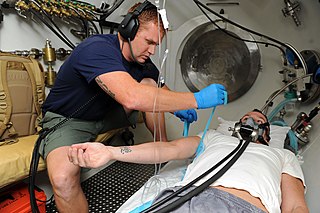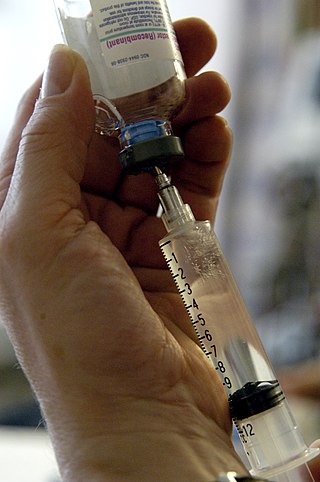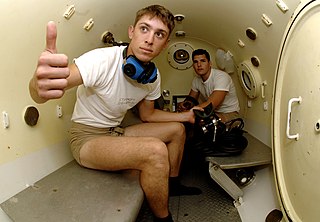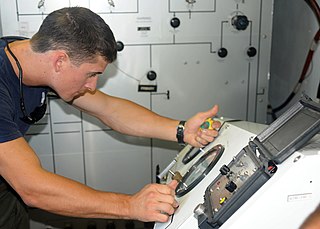Related Research Articles

Decompression sickness is a medical condition caused by dissolved gases emerging from solution as bubbles inside the body tissues during decompression. DCS most commonly occurs during or soon after a decompression ascent from underwater diving, but can also result from other causes of depressurisation, such as emerging from a caisson, decompression from saturation, flying in an unpressurised aircraft at high altitude, and extravehicular activity from spacecraft. DCS and arterial gas embolism are collectively referred to as decompression illness.

Hyperbaric medicine is a medical treatment in which an increase in barometric pressure over ambient pressure is employed increasing the partial pressures of all gasses present in the compressed air. The immediate effects include reducing the size of gas embolisms and raising the partial pressures of all gasses present according to Henry's law. Currently, there are two types of hyperbaric medicine depending on the gases compressed, hyperbaric air and hyperbaric oxygen.

An air embolism, also known as a gas embolism, is a blood vessel blockage caused by one or more bubbles of air or other gas in the circulatory system. Air can be introduced into the circulation during surgical procedures, lung over-expansion injury, decompression, and a few other causes. In flora, air embolisms may also occur in the xylem of vascular plants, especially when suffering from water stress.

Barotrauma is physical damage to body tissues caused by a difference in pressure between a gas space inside, or in contact with, the body and the surrounding gas or liquid. The initial damage is usually due to over-stretching the tissues in tension or shear, either directly by an expansion of the gas in the closed space or by pressure difference hydrostatically transmitted through the tissue. Tissue rupture may be complicated by the introduction of gas into the local tissue or circulation through the initial trauma site, which can cause blockage of circulation at distant sites or interfere with the normal function of an organ by its presence. The term is usually applied when the gas volume involved already exists prior to decompression. Barotrama can occur during both compression and decompression events.
Decompression Illness (DCI) comprises two different conditions caused by rapid decompression of the body. These conditions present similar symptoms and require the same initial first aid. Scuba divers are trained to ascend slowly from depth to avoid DCI. Although the incidence is relatively rare, the consequences can be serious and potentially fatal, especially if untreated.
In-water recompression (IWR) or underwater oxygen treatment is the emergency treatment of decompression sickness (DCS) by returning the diver underwater to help the gas bubbles in the tissues, which are causing the symptoms, to resolve. It is a procedure that exposes the diver to significant risk which should be compared with the risk associated with the available options and balanced against the probable benefits. Some authorities recommend that it is only to be used when the time to travel to the nearest recompression chamber is too long to save the victim's life; others take a more pragmatic approach and accept that in some circumstances IWR is the best available option. The risks may not be justified for case of mild symptoms likely to resolve spontaneously, or for cases where the diver is likely to be unsafe in the water, but in-water recompression may be justified in cases where severe outcomes are likely if not recompressed, if conducted by a competent and suitably equipped team.
Dysbarism refers to medical conditions resulting from changes in ambient pressure. Various activities are associated with pressure changes. Underwater diving is the most frequently cited example, but pressure changes also affect people who work in other pressurized environments, and people who move between different altitudes.

Diving medicine, also called undersea and hyperbaric medicine (UHB), is the diagnosis, treatment and prevention of conditions caused by humans entering the undersea environment. It includes the effects on the body of pressure on gases, the diagnosis and treatment of conditions caused by marine hazards and how relationships of a diver's fitness to dive affect a diver's safety. Diving medical practitioners are also expected to be competent in the examination of divers and potential divers to determine fitness to dive.
Diving disorders, or diving related medical conditions, are conditions associated with underwater diving, and include both conditions unique to underwater diving, and those that also occur during other activities. This second group further divides conditions caused by exposure to ambient pressures significantly different from surface atmospheric pressure, and a range of conditions caused by general environment and equipment associated with diving activities.

A diving chamber is a vessel for human occupation, which may have an entrance that can be sealed to hold an internal pressure significantly higher than ambient pressure, a pressurised gas system to control the internal pressure, and a supply of breathing gas for the occupants.
National Board of Diving and Hyperbaric Medical Technology (NBDHMT), formally known as the National Association of Diving Technicians, is a non-profit organization devoted to the education and certification of qualified personnel in the fields of diving and hyperbaric medicine.

The decompression of a diver is the reduction in ambient pressure experienced during ascent from depth. It is also the process of elimination of dissolved inert gases from the diver's body which accumulate during ascent, largely during pauses in the ascent known as decompression stops, and after surfacing, until the gas concentrations reach equilibrium. Divers breathing gas at ambient pressure need to ascend at a rate determined by their exposure to pressure and the breathing gas in use. A diver who only breathes gas at atmospheric pressure when free-diving or snorkelling will not usually need to decompress. Divers using an atmospheric diving suit do not need to decompress as they are never exposed to high ambient pressure.
Hypobaric decompression is the reduction in ambient pressure below the normal range of sea level atmospheric pressure. Altitude decompression is hypobaric decompression which is the natural consequence of unprotected elevation to altitude, while other forms of hypobaric decompression are due to intentional or unintentional release of pressurization of a pressure suit or pressurized compartment, vehicle or habitat, and may be controlled or uncontrolled, or the reduction of pressure in a hypobaric chamber.

Hyperbaric treatment schedules or hyperbaric treatment tables, are planned sequences of events in chronological order for hyperbaric pressure exposures specifying the pressure profile over time and the breathing gas to be used during specified periods, for medical treatment. Hyperbaric therapy is based on exposure to pressures greater than normal atmospheric pressure, and in many cases the use of breathing gases with oxygen content greater than that of air.
Brian Andrew Hills, born 19 March 1934 in Cardiff, Wales, died 13 January 2006 in Brisbane, Queensland, was a physiologist who worked on decompression theory.

A built-in breathing system is a source of breathing gas installed in a confined space where an alternative to the ambient gas may be required for medical treatment, emergency use, or to minimise a hazard. They are found in diving chambers, hyperbaric treatment chambers, and submarines.
Inner ear decompression sickness, (IEDCS) or audiovestibular decompression sickness is a medical condition of the inner ear caused by the formation of gas bubbles in the tissues or blood vessels of the inner ear. Generally referred to as a form of decompression sickness, it can also occur at constant pressure due to inert gas counterdiffusion effects.
Middle ear barotrauma (MEBT), also known to underwater divers as ear squeeze and reverse ear squeeze, is an injury caused by a difference in pressure between the external ear canal and the middle ear. It is common in underwater divers and usually occurs when the diver does not equalise sufficiently during descent or, less commonly, on ascent. Failure to equalise may be due to inexperience or eustachian tube dysfunction, which can have many possible causes. Unequalised ambient pressure increase during descent causes a pressure imbalance between the middle ear air space and the external auditory canal over the eardrum, referred to by divers as ear squeeze, causing inward stretching, serous effusion and haemorrhage, and eventual rupture. During ascent internal over-pressure is normally passively released through the eustachian tube, but if this does not happen the volume expansion of middle ear gas will cause outward bulging, stretching and eventual rupture of the eardrum known to divers as reverse ear squeeze. This damage causes local pain and hearing loss. Tympanic rupture during a dive can allow water into the middle ear, which can cause severe vertigo from caloric stimulation. This may cause nausea and vomiting underwater, which has a high risk of aspiration of vomit or water, with possibly fatal consequences.
Alf Ottar Brubakk was a Norwegian researcher and professor at the Faculty of Medicine and Health Sciences Department of Circulation and Imaging (ISB) of the Norwegian University of Science and Technology in Trondheim, Norway. He worked in the physiology of underwater diving, particularly decompression, was an advisor on diving physiology to the offshore diving industry, and a president of the European Underwater and Baromedical Society.
References
- ↑ Josefsen, L; Woodward, C; Lewis, D; Hodge, J; Camporesi, EM (1997). "The nursing role in hyperbaric medicine". Undersea and Hyperbaric Medicine (Annual Meeting Abstract). Archived from the original on April 15, 2013. Retrieved 2011-01-14.
{{cite journal}}: CS1 maint: unfit URL (link) - ↑ Greenberg, DA (1985). "Baromedical nursing specialization". Undersea and Hyperbaric Medicine (Annual Meeting Abstract). Archived from the original on April 15, 2013. Retrieved 2011-01-14.
{{cite journal}}: CS1 maint: unfit URL (link) - ↑ "Baromedical Nurses Association Certification". Baromedical Nurses Association. Archived from the original on 2014-05-15. Retrieved 2011-01-14.
- 1 2 3 4 5 Howell, Raelina S.; Criscitelli, Theresa; Woods, Jon S.; Gillette, Brian M.; Gorenstein, Scott (2018). "Hyperbaric Oxygen Therapy: Indications, Contraindications, and Use at a Tertiary Care Center". AORN Journal. 107 (4): 442–453. doi:10.1002/aorn.12097. ISSN 1878-0369. PMID 29595909. S2CID 4386746.
- 1 2 Stevens, Sarah (October 2016). "Implementing a Nurse-Driven Protocol to Manage Diabetic Patients in Hyperbarics". Western Journal of Nursing Research. 38 (10): 1383–1384. doi:10.1177/0193945916658193. ISSN 0193-9459. PMID 27655088. S2CID 11627987.
- ↑ "Psychological Nursing Of Hyperbaric Oxygen Therapy". oxygen-ark.com. 2023-08-17. Retrieved 2023-09-14.
- ↑ "Hyperbaric Physics". National Library of Medicine. StatPearls. Retrieved April 28, 2024.